Captured Japanese, American and Soviet armored vehicles at the Military Museum of the Chinese Revolution
On the ground floor of the Military Museum of the Chinese Revolution in Beijing, there is an exhibition hall where a rich collection of artillery pieces, mortars, multiple launch rocket systems, anti-aircraft mounts and armored vehicles of Japanese, American, Soviet and Chinese production is presented.
At the entrance to the hall, visitors are greeted by the Soviet medium tank T-62 and the heavy American tank M26 Pershing. Both of these machines are trophies of the People's Liberation Army of China.
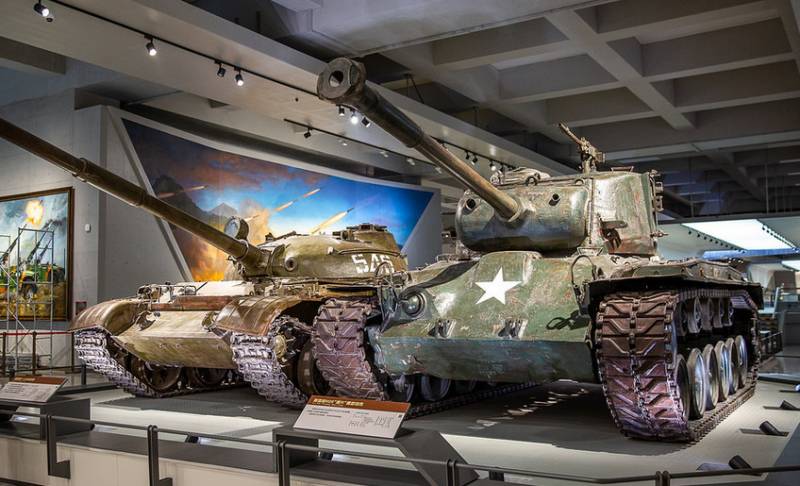
Photo: Said Aminov, saidpvo.lj.com
Tanks T-62 and M26 installed at the entrance to the hall of armored vehicles and artillery
During the fighting on the Korean Peninsula, it turned out that the M24 Chaffee and M4 Sherman tanks are very vulnerable to the fire of anti-tank weapons available to the North Korean army and Chinese volunteers. In this regard, the American command wanted to have a tank whose frontal armor at real combat distances could withstand the hit of armor-piercing shells fired from the T-34-85 cannon.
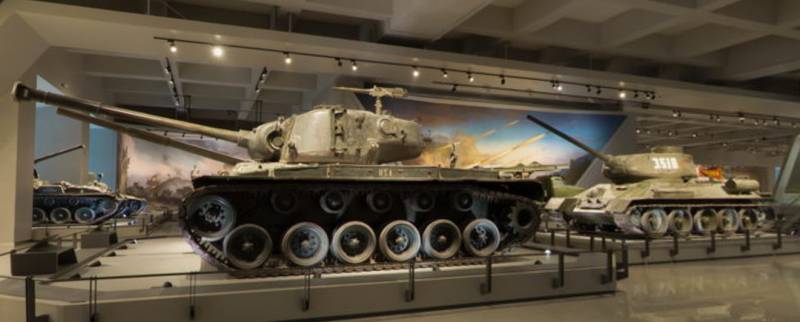
Photo: Said Aminov, saidpvo.lj.com
American heavy tank M26. In the background, his rival in the battles in Korea is the Soviet T-34-85
According to official US data, 309 Pershing tanks were sent to Korea. M26 crews chalked up 29 North Korean T-34-85s. However, the Americans admit that during the tank duels “thirty-fours” were killed 6 “Pershing”. From July 1950 to January 21, 1951, 252 Pershing tanks took part in the fighting, of which 156 tanks were out of order, including 50 tanks that were completely destroyed or captured. From January 21 to October 6, 1951, for technical reasons and from enemy fire, 170 M26 tanks went out, how many of them were lost forever is not known.
The frontal armor of the hull and turret with a thickness of 102 mm could be penetrated by the “thirty-four” gun only from a very close distance. In turn, the 90-mm gun, which was equipped with the Pershing, hit the T-34-85 at a distance of up to 2 km. Thus, in terms of firepower and level of protection, the M26 was approximately equivalent to the German Tiger. However, heavy tanks were not suitable for the conditions of Korea. "Pershing" skidded on the mountain slopes, and the flimsy Korean bridges through numerous rivers and streams could not stand the car, whose mass exceeded 43 tons.
After the front line stabilized, the main function of the American heavy tanks participating in the Korean War was the fire support of infantry units and the fight against enemy manpower. For this, in addition to the 90 mm guns, a 12,7 mm machine gun mounted on the turret and two 7,62 mm machine guns were used. Although the fire capabilities of the Pershing were quite high, due to poor mobility and low technical reliability, the M26 was used only in the first half of the war on the Korean Peninsula.
An information plate installed next to the Soviet T-62 tank says that this vehicle was captured by PLA border guard troops in March 1969 during a border conflict with the USSR on Damansky Island.
The KDVO command sent several T-62 tanks to support Soviet border guards who lacked heavy equipment. At the same time, one Soviet tank, when trying to get around the Chinese troops that were seated on the island, was hit by a cumulative rocket grenade. After dark, the Chinese troops were able to dismantle night vision devices and an weapon stabilizer, which were secret at the time, from the tank remaining in the Chinese forces. Subsequently, the fire around the wrecked tank was broken by the fire of 120 mm mortars, and it sank. However, after the ceasefire, the Chinese managed to raise the T-62, return it to working condition and test it.
T-62 became the first in the USSR serial tank armed with a smooth-bore 115-mm gun U-5TS "Hammer". Compared with the 100-mm D-10T tank gun mounted on the T-54 and T-55 tanks, the U-5TS gun had better armor penetration, however, the practical rate of fire of the 115 mm gun was less than that of the 100 mm gun. The design of the T-62 was close to the T-54 / T-55, with these machines there was a high degree of continuity in the internal equipment, components and assemblies. The security of the T-62 hull remained at the T-55 level, but the turret’s armor became thicker.
Chinese experts thoroughly studied the captured T-62, revealing its advantages and disadvantages. Of particular interest were the smooth-bore gun with feathered projectiles, a fire control system, an arms stabilizer, and night vision devices. At the same time, China refrained from copying the 115-mm U-5TS guns. The captured T-62 was at the test site until the mid-1980s, after which it was transferred to the Beijing Military Museum of the Chinese Revolution.
In the arsenal of detachments of the Chinese Communists, fighting the Kuomintang troops, there were many captured Japanese armored vehicles. In particular, there is a Type 94 wedge in the museum’s exposition. Machines of this type were used by the Japanese Imperial Army as light tractors and for reconnaissance.
An armored tracked vehicle armed with one 6,5-mm Type 91 machine gun or 7,7-mm Type 97 machine gun was developed in 1933 by Tokyo Electric Gas Co., Ltd. The thickness of the strongly inclined frontal sheet and machine gun mask was 12 mm, the stern sheet - 10 mm, the walls of the tower and the sides of the hull - 8 mm, the roof and the bottom - 4 mm. Crew - 2 people. 32 hp carburetor engine Accelerated on the highway a car weighing 3,5 tons to 40 km / h.
During the fighting in the second half of the 1940s, several Japanese Type 97 tanks were captured by the Chinese Communists. In Japan, the Type 97 was considered a medium tank, but according to the generally accepted classification, it was rather light. The combat weight of the tank was 15,8 tons. At the same time, it was approximately on the same level of protection as the Soviet BT-7. The upper part of the Type 97 frontal sheet was 27 mm thick, the middle part was 20 mm, the lower part was 27 mm. Side armor - 20 mm. Tower and feed - 25 mm. The tank was armed with a 57 mm cannon and two 7,7 mm machine guns. 170 hp diesel allowed to develop a speed of 38 km / h on the highway. Crew - 4 people. The Type 97 tank was in production from 1938 to 1943. During this period, more than 2100 copies were collected.
The museum has a Type 97 tank with a new turret and a 47 mm long-barrel cannon. Serial production of this model began in 1940. This modification was created with the aim of increasing anti-tank capabilities. Despite the smaller caliber, due to the high initial velocity of the projectile, the 47-mm gun significantly exceeded the 57-mm gun in armor penetration. Tanks of this modification were produced in parallel with the basic version.
At the place of honor in the museum’s exposition is placed a “tank-hero” Type 97 with a 47-mm cannon. According to the official Chinese stories it is the very first tank used by communist forces led by Mao Dzedong. The Type 97 tank was captured at a Japanese tank repair facility in Shenyang in November 1945. This combat vehicle participated in battles in Jiannan, Jinzhou and Tianjin. During the battles for Jinzhou in 1948, the crew of the tank under the command of Dong Laifu broke through the defense of the Kuomintang troops. In 1949, this tank participated in a military parade on the foundation of the PRC.
The Italian CV CV tank, captured by the PLA in 33 after the liberation of Shanghai, is installed in the collection of captured armored vehicles. The machines of this type were used by the Kuomintang for communications and reconnaissance.
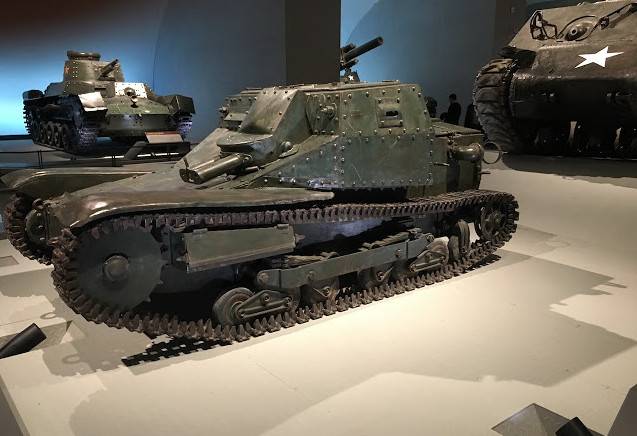
Photo: Said Aminov, saidpvo.lj.com
Wedge Heel CV33
Wedge Wedge CV33, manufactured by Italian firms Fiat and Ansaldo since the mid-1930s, was created based on the British Carden-Loyd Mk VI. In total, more than 1940 tankettes were built before 1500. Most of them are exported. About 100 units were delivered to China.
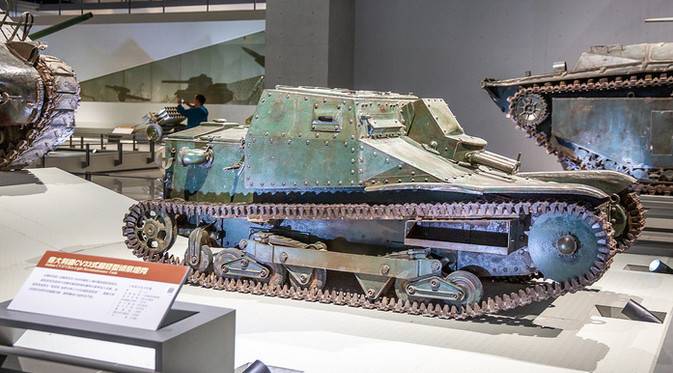
Photo: Said Aminov, saidpvo.lj.com
Initially, the CV33 was armed with a 6,5 mm Fiat Mod.14 machine gun, but in China the cars were rearmed with Japanese 7,7 mm machine guns. The thickness of the frontal armor of the hull and wheelhouse was 15 mm, the side and the feed were 9 mm. With a mass of 3,5 tons, the wedge, equipped with a carburetor engine with a power of 43 hp, could accelerate to 42 km / h.
Another trophy available at the museum is the American-made M3A3 Stuart light tank captured from the Kuomintang. From 1941 to 1944, more than 23 light tanks of the M000 family were built in the United States. In addition to the American army, these machines were widely supplied to the Allies. More than a hundred Stuart tanks were transferred to the Kuomintang, some of them went to the PLA.
For the light tank, the M3 was well protected. The upper part of the frontal sheet with an inclination angle of 17 ° had a thickness of 38 mm, the middle armor sheet with an inclination angle of 69 ° had a thickness of 16 mm, and the lower armor plate was 44 mm. The thickness of the side armor and stern is 25 mm. Tower forehead - 38 mm, side of the tower -25 mm. The tower had a 37 mm cannon and a 7,62 mm machine gun coaxial with it. Another machine gun was located in a ball mount in the frontal sheet of the hull and was serviced by a shooter. On the roof of the tower, on a pivot mount mounted anti-aircraft machine gun rifle caliber. 250 hp carburetor engine provided the machine with a mass of 12,7 tons good mobility. On a good road, the Stuart could accelerate to 60 km / h.
This tank was recaptured by the Chiang Kai-shek during the battles for South Shandong in January 1947. Later, this M3A3 was introduced into the tank forces of the East China Field Army, and he participated in the Jinan and Huaihai campaigns. During the battle for Jinan in Yonggumen, the crew of the tank with tail number "568" under the leadership of Shen Xu played an important role. After the battle was over, the Stuart received the honorary title “Honored Tank”, and the tank commander Shen Xu - “Iron Man Hero”. In 1959, he was transferred from Tank Academy No. 1 to the Beijing Military Museum.
An LVT (A) 1 tracked armored amphibian is installed in the exhibition hall next to the Stuart. The machine has a 6-12 mm thick bulletproof armor, and an M5A1 tank turret with a 37 mm cannon and a 7,62 mm machine gun coaxial with it. Additionally, in the aft part above the hatches two machine guns of a rifle caliber could be installed. Aft hatches were intended for the safe disembarkation of the crew. The mass of the combat vehicle was 15 tons, the crew - 6 people. The 250-horsepower engine provided speeds of 32 km / h on land and 12 km / h on water. Outwardly, the car looked high and awkward, but it turned out to be a rather useful means of fire support for landing when landing on shore. For their time, these amphibious tanks, capable of providing fire support to the landing, were a big step forward, but due to weak protection, large dimensions and low mobility, they were very vulnerable to anti-tank weapons.
In May 1949, during the liberation of Shanghai, the People's Liberation Army captured several tracked amphibians LVT (A) 1. After the formation of the PRC, these machines were equipped with a battalion, which was included in the first PLA marine regiment. In addition to the LVT (A) 1 with a 37-mm cannon, the PLA had at its disposal floating fire support tanks LVT (A) 4, armed with a 75-mm howitzer, 7,62 and 12,7-mm machine guns. To enhance the anti-tank properties of the LVT (A) 4, Chinese experts in the mid-1950s installed a Soviet 75-mm ZiS-57 gun instead of a tower with a 2 mm howitzer in some mid-XNUMXs.
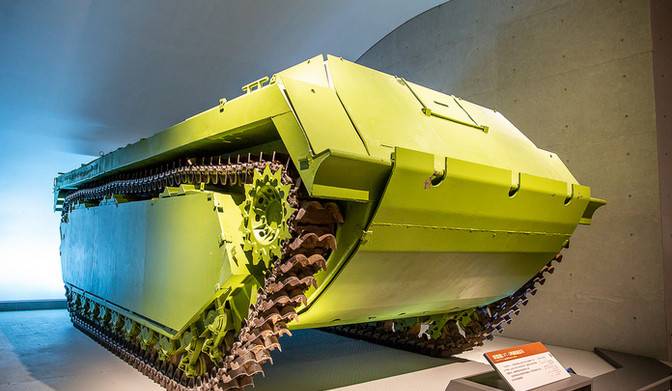
Photo: Said Aminov, saidpvo.lj.com
Floating conveyor LVT-3
Together with amphibious tanks in the vicinity of Shanghai, in 1949, LVT-3 amphibious carriers were captured. The armament of this machine usually included one 12,7 mm M2NV machine gun and two 7,62 mm M1919A4 on pivot mounts. Armor plates could be attached to the LVT-3 body, but at the same time its carrying capacity decreased from 3,6 to 1,3 tons. The floating LVT-3 transporter could carry 30 armed soldiers or a jeep. The exploitation of American amphibious tanks and carriers in the PRC continued until the early 1970s.
The first American tank used in the fighting in Korea was the M24 Chaffee. This light tank in terms of protection was comparable with the M3A3 Stuart, but significantly superior to it in armament. The main weapons The Chaffee was the M75 lightweight 6 mm gun, which in terms of ballistic performance corresponded to the 75 mm M2 and M3 tank guns mounted on the M3 Lee and M4 Sherman medium tanks. A 7,62 mm M1919A4 machine gun was paired with a cannon, another was located in a ball mount in the front of the hull. On the turret, on the roof of the tower mounted anti-aircraft 12,7-mm machine gun M2NV.
On July 10, 1950, the Chaffee met in the first tank battle of the Korean War with the T-34-85, which formed the basis of North Korean tank forces. In this case, the inability of the M24 lungs to compete with the “thirty-fours” on an equal footing was revealed. The thin armor of light American tanks turned out to be very vulnerable not only to 85-mm shells of tank guns, it was also easily pierced by armor-piercing shells of 76-mm ZiS-3 divisions, 57-mm ZiS-2 guns and 45-mm M-42 guns. When operating against the Chaffee infantry, the 14,5-mm anti-tank rifles suffered greatly from the fire. The American Chaffee suffered serious losses, only from July 1, 1950 to October 6, 1951 195 M24 tanks were disabled, about half of them were irretrievably lost.
Already in August 1950, the M24 in the American tank units operating in Korea began to be replaced with medium M4 Sherman and heavy M26 Pershing. Nevertheless, until the armistice in July 1953, the Chaffee continued to be used as auxiliary and reconnaissance tanks, which was facilitated by the difficult terrain in Korea. Often heavier tanks could not climb the hillsides or force the steep banks of the streams.
This M24 was captured by the Chinese People's Volunteer Army in December 1950. After which he was taken out for study to the territory of the PRC. Several of these machines, which became the trophies of Chinese volunteers, were briefly used against the "UN troops" and were destroyed by the American aviation in March 1951 of the year.
The main enemy of the North Korean and Chinese T-34-85 from the fall of 1950 became the American Sherman medium tanks of the M4A3 and M4A4 modifications. The British forces were armed with Sherman Firefly. According to official American data, from July 21, 1950 to January 21, 1951, 516 M4A3 were involved in hostilities, of which more than 220 tanks were out of order, 120 vehicles were irretrievably lost. On April 1, 1951, there were 442 M4A3 tanks in Korea. From January 21 to October 6, 1951, 178 tanks of this type were lost. From April 8 to October 6, 1951, more than 500 Sherman tanks of all modifications were destroyed and destroyed.
The museum has two Sherman tanks of the M4A3 modification. Apparently, one M4A3 was captured damaged, since this machine left a small chunk from the gun barrel.
A significant number of broken and wrecked tanks were captured by the North Koreans and the Chinese. It is known that about two dozen captured Shermans fought against their former masters. An explanatory plate for the M4A3E8 tank says that this machine with a 76 mm long-barrel gun became the trophy of Chinese volunteers in December 1950, in the Jiechuan area in the north of the Korean Peninsula.
In terms of fire characteristics and security, the Sherman and T-34-85 tanks were approximately equivalent. The long-barreled 76-mm M4A3 gun and the 85-mm T-34-85 cannon confidently pierced the armor of their opponent at real combat distances. At the same time, the high-explosive and fragmentation effect of the 85-mm shell was significantly higher, and it was better suited for the destruction of field fortifications and the destruction of enemy manpower. At the same time, American tank crews had a higher level of training, which affected the results of tank battles.
M36 anti-tank self-propelled guns, which had much in common with Sherman, also took part in the hostilities in Korea. Serial production of this tank destroyer began in the second half of 1944. Depending on the modification, the chassis of the M10 self-propelled gun or the M4A3 tank was used. Unlike linear tanks and tank destroyers M10 with 76 mm gun, self-propelled gun M36 was armed with a 90 mm gun M3, designed on the basis of anti-aircraft guns. The 90 mm M3 gun was one of the most powerful serial anti-tank weapons available to the U.S. Army in the early 1950s. The security of the M36 hull, depending on the modification, corresponded to the tank destroyer M10 or the M4A3 tank. The cast turret with a 90-mm gun in front was covered with 76 mm of armor, the sides of the turret were 32 mm thick. On the self-propelled guns of the first series, the tower was open, and later a roof was installed from light anti-fragmentation armor. Auxiliary armament M36 consisted of a 12,7-mm machine gun M2HB, located in the pivot installation on the roof of the stern niche of the tower.
After the “UN troops” arrived in Korea, the USSR began supplying IS-2 and ISU-122 heavy tanks to the DPRK and China, and anti-tank self-propelled guns with a 90-mm gun were in great demand.
The explanatory plate for this M36 says that the self-propelled gun was at the disposal of the Chinese in the fall of 1951. She was abandoned by the Americans on the territory of the DPRK in the vicinity of Wonsan.
Since the fall of 1951, Americans have been very intensively using the M19A1 ZSU in combat. This machine, on the chassis of the M24 Chaffee light tank, is armed with twin 40 mm anti-aircraft guns with a total rate of fire of 240 rounds / min. Ammunition carried 352 shells. Given the fact that American aircraft dominated the air over South Korea, and the Soviet MiG-15 did not cross the 38th parallel, anti-aircraft self-propelled guns were actively used against ground targets.
M19 anti-aircraft installations did not have the destructive power of tanks or self-propelled guns, but they had their own trump card - high rate of fire, accuracy and density of fire. Light anti-aircraft self-propelled guns were an indispensable means of repelling the massive attacks of the Chinese and North Korean infantry. In mountainous and hilly areas, accurate direct-fire shooting and the ability to release the maximum number of shells in a short period of time were especially appreciated. Therefore, self-propelled guns tried to raise as high as possible. In this regard, the M19 ZSU were more preferable than the Sherman tanks. At the same time, the fighting compartments of these vehicles, opened at the top, did not provide reliable protection for the calculation from machine-gun fire and artillery and mortar shelling.
Shortly before the cessation of full-scale hostilities on the Korean Peninsula in July 1953, during a counterattack, the Chinese People’s Volunteer Army in the Phenkang area captured an American self-propelled 155-mm howitzer M41 Gorilla. Although these vehicles in the American army had only 85 units, they actively fought in Korea.
As the base of the self-propelled guns, the chassis of the light tank M24 Chaffee was used, on which a 155-mm M114 howitzer was installed. To ensure stability during firing, a fodder opener was used. This device consisted of two support beams and a blade with stops for deepening into the ground. The mass of the M41 self-propelled guns in the combat position was 19,3 tons. Two engines with a capacity of 110 hp each allowed to accelerate along the highway to 56 km / h. The crew of the self-propelled gun was 5 people, the maximum firing range of 14 km, rate of fire - 2 rounds per minute.
Between the American "Sherman" and the Soviet T-34-85, a lightweight tracked floating M29C Water Weasel transporter was placed in the museum's exposition. In order to ensure buoyancy in the bow and stern of the M29C hull, removable rigid pontoons could be attached. Movement afloat was carried out by rewinding the tracks. The mass of the machine without cargo was 1,8 tons, it was possible to transport 4 paratroopers. 70 hp engine on land it provided speeds of up to 55 km / h and 6 km / h afloat.
This machine showed itself very well in Korea as a conveyor of personnel and various cargoes. Small mobile all-terrain vehicles with a carrying capacity of 700 kg, passing even through the swamp, deserved recognition in the troops. The Vizeli also occasionally had heavy machine guns and recoilless 57 and 75 mm guns, turning them into fire support vehicles. To protect against bullets and chips, additional armor was hung on the hull, but at the same time the car was deprived of the ability to overcome water obstacles by swimming and the carrying capacity was reduced.
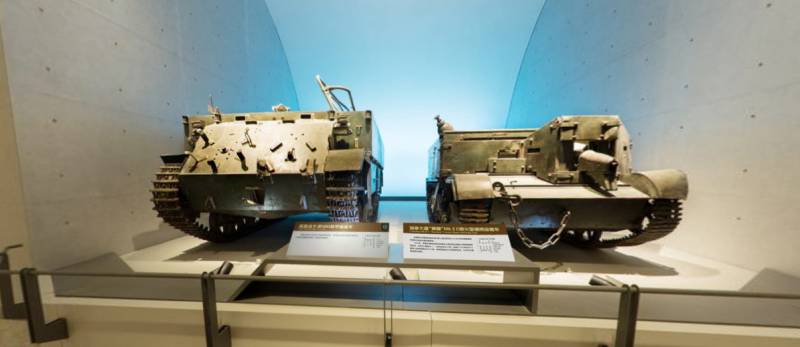
Photo: Said Aminov, saidpvo.lj.com
Crawler Conveyor Oxford Carrier MK I and Wasp Mk IIC Self-propelled Flamethrower
In addition to the M29C Water Weasel, "UN troops" used other tracked transporters in Korea. The museum has a British-made conveyor Oxford Carrier MK I and a Canadian self-propelled flamethrower Wasp Mk IIС.
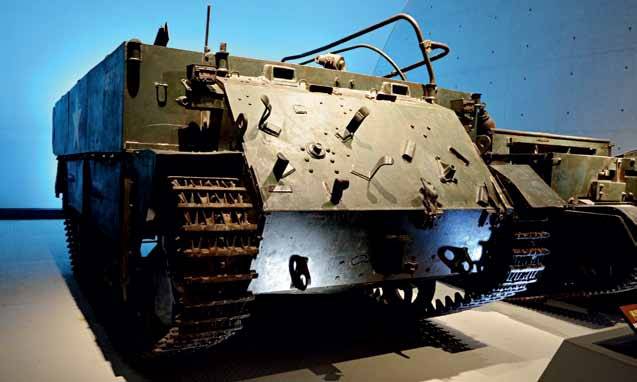
Photo: Said Aminov, saidpvo.lj.com
Armored personnel carrier Oxford Carrier MK I
The Oxford Carrier MK I in Korea was at the disposal of the British, Canadian and Australian contingents. It was operated as an armored personnel carrier and light artillery tractor. The machine, weighing about 7,5 tons, was covered with bulletproof armor, and thanks to a 110 hp carburetor engine. speeds up to 50 km / h. A British-made armored personnel carrier presented at the museum was captured by Chinese forces in December 1950.
The Canadian-made Wasp Mk IIC self-propelled flamethrower on the Universal Carrier chassis had a 341 liter capacity for the fire mix placed on the mounts behind the rear of the hull. A gas bottle was located inside the machine. The range of the flamethrower, depending on the direction and strength of the wind, was 60-70 m. For self-defense, a BREN light machine gun was used, fire from which could be fired from a turret or from loopholes, being protected by an armored corps. There was the possibility of transporting several fighters, although in this case there was a risk of reduced mobility due to exceeding the maximum load capacity.
In the "UN troops" and in the South Korean army in the initial period of the war, there were several dozen American M8 Greyhound wheeled armored vehicles. These rather successful armored cars were mainly used for reconnaissance, patrolling, message delivery and escort of transport convoys.
Serial production of the "Beagle" began in 1943, and before the end of World War II, it was possible to produce more than 8500 cars. The armament of the M8 armored car was the same as that of the M3A3 Stuart tank. The frontal armor was 13-19 mm thick, the side and the stern were 10 mm thick, the turret was 19 mm thick. Crew - 4 people. The machine, weighing more than 7800 kg, with an engine capacity of 110 hp it accelerated along the highway to 85 km / h.
With the correct use of M8 armored vehicles, they were completely justified, but in the event of a collision with tanks or falling under artillery and mortar shelling, they suffered heavy losses. Available at the Military Museum of the Chinese Revolution, the M8 armored car was recaptured from the Chiang Kai-shek during the battle for Shanghai in May 1949.
In the following parts of the photo tour of the Military Museum of the Chinese Revolution in Beijing, we look at the Chinese-made armored vehicles available here, multiple launch rocket systems, anti-aircraft guns and artillery.
To be continued ...
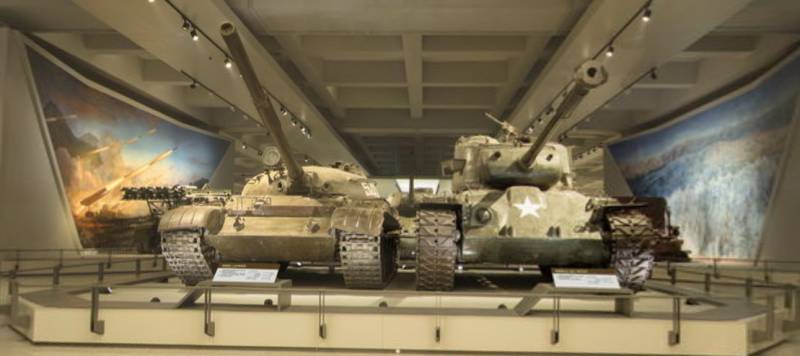
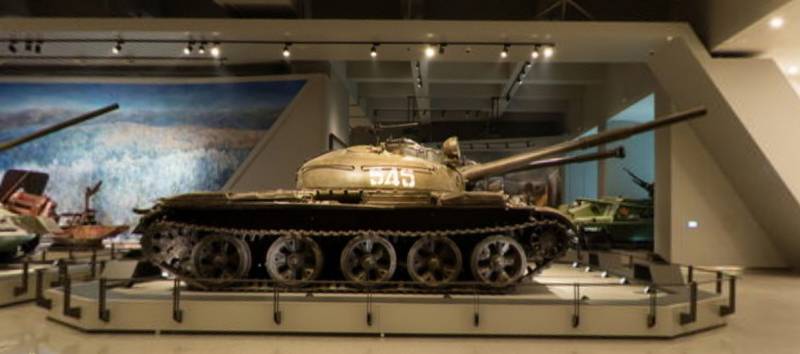
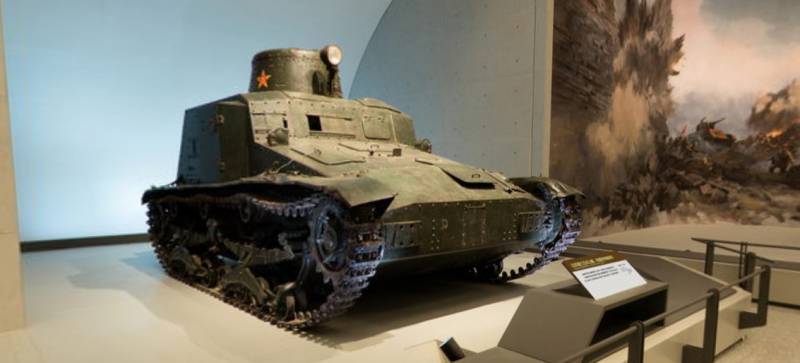
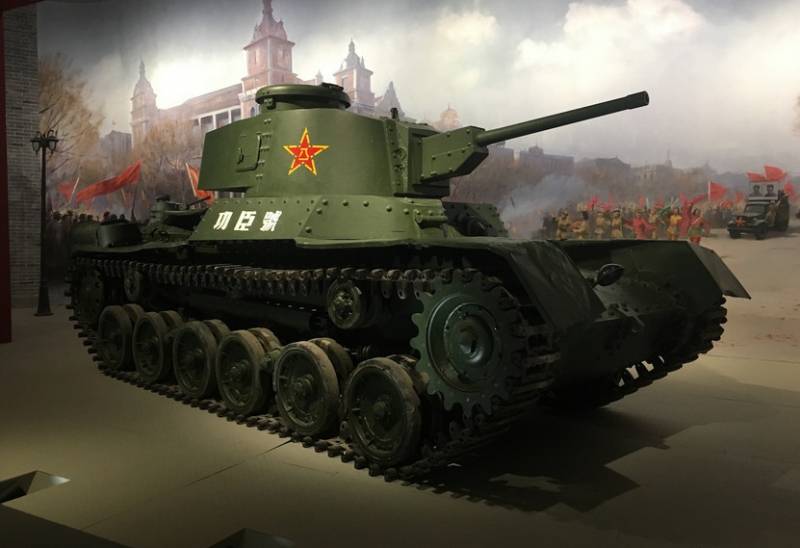

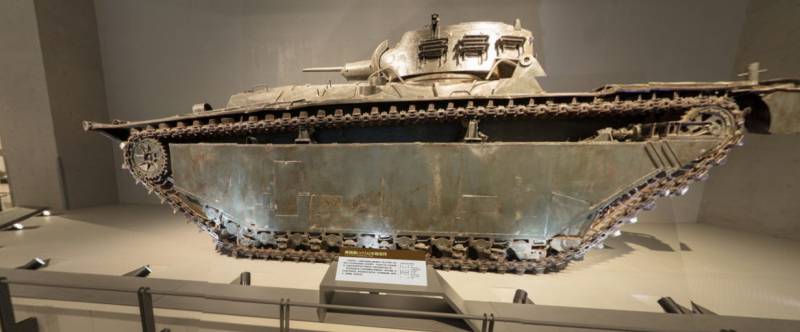
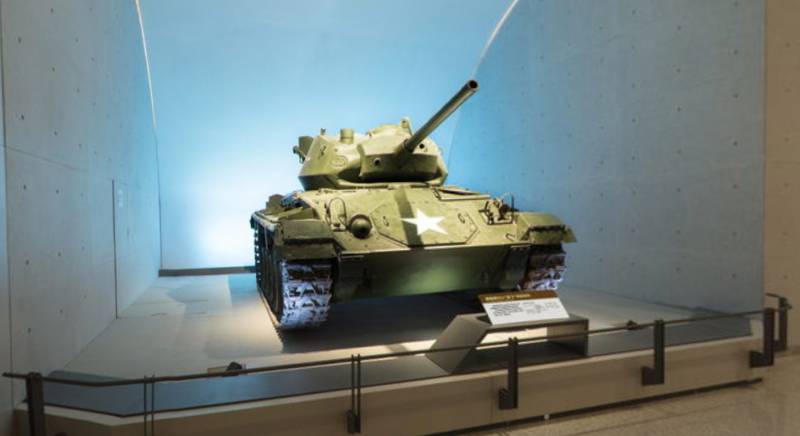
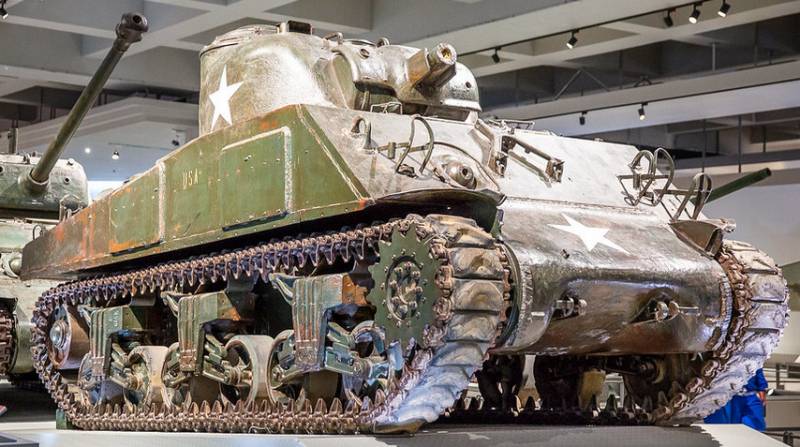
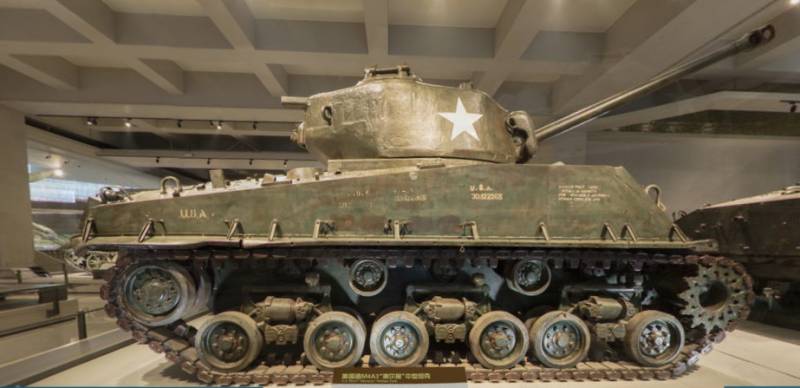
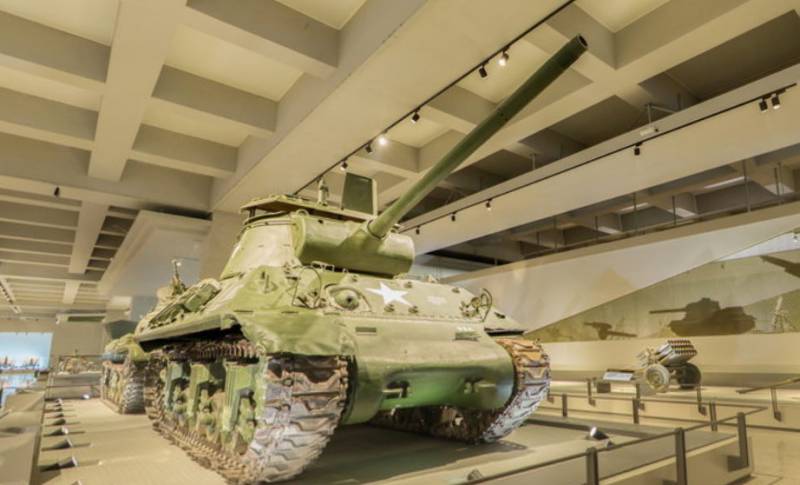
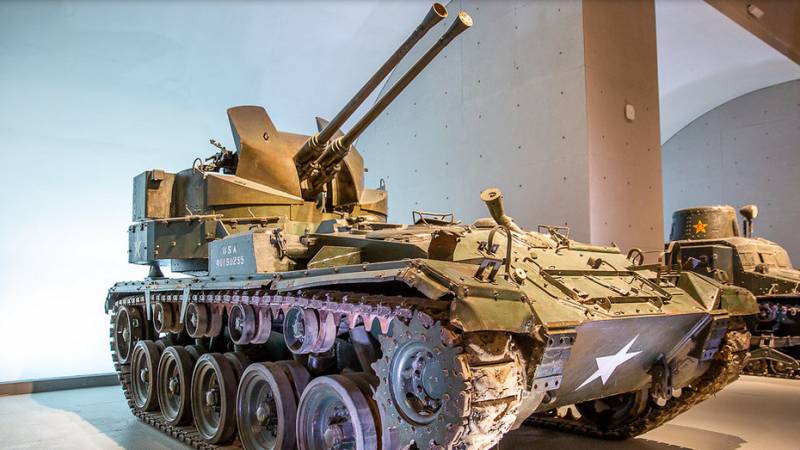
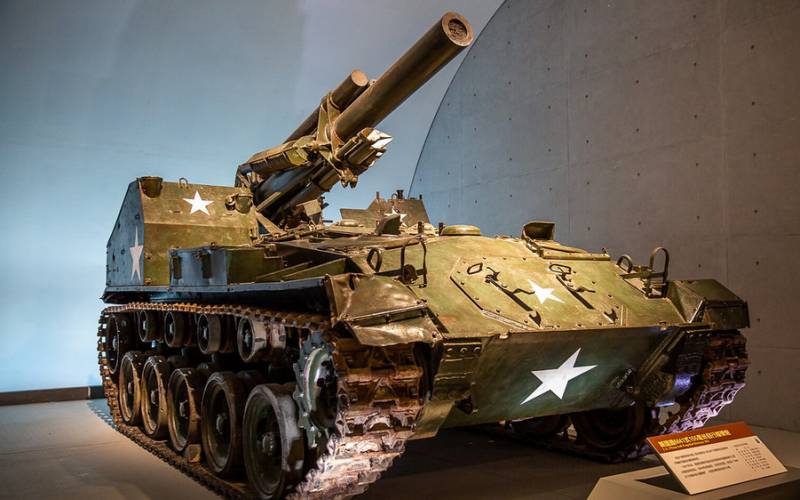
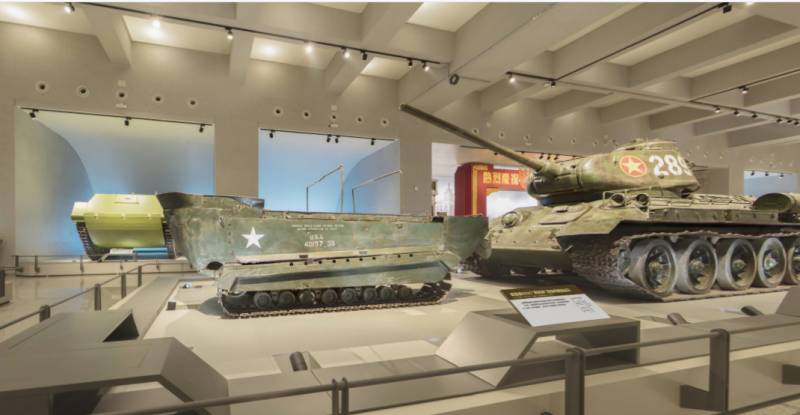
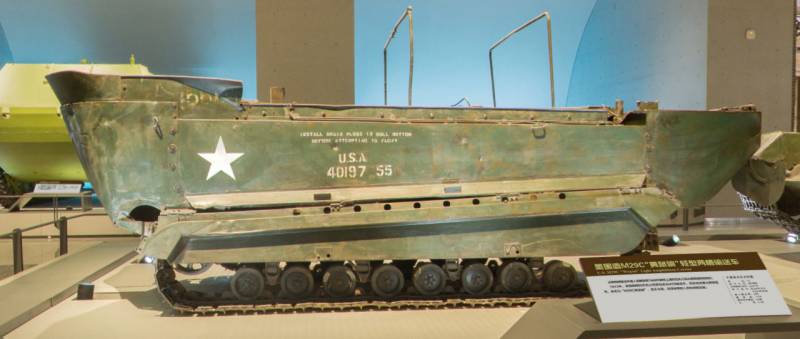
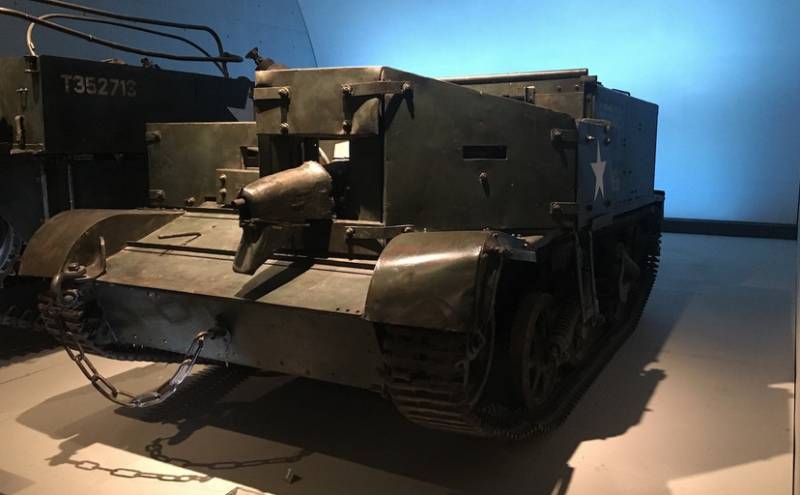
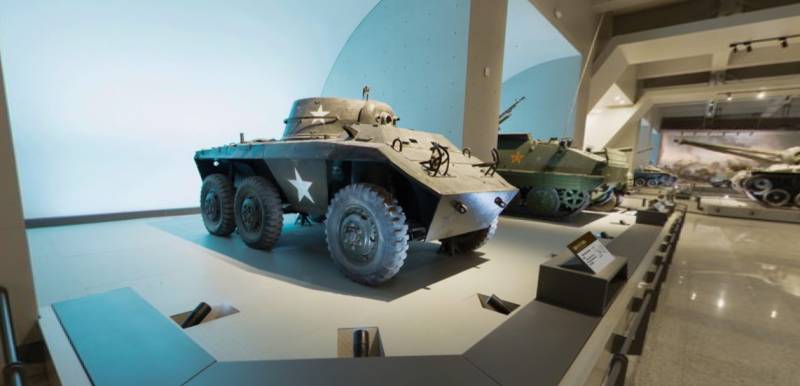
Information